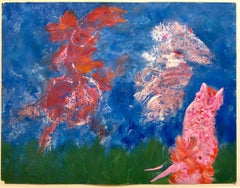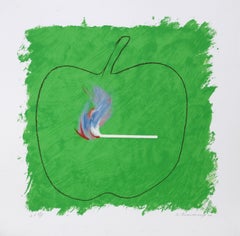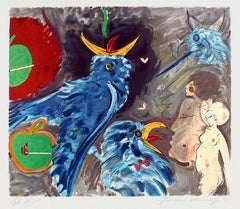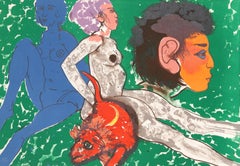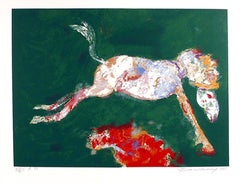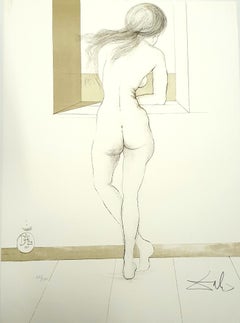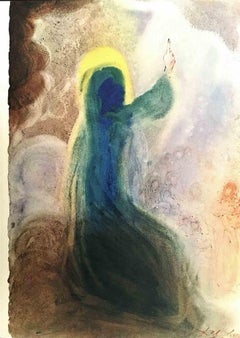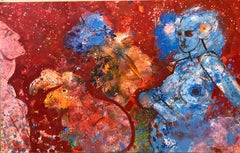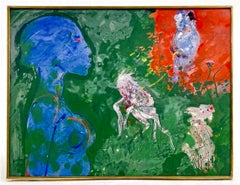Robert Beauchamp Art
to
12
5
1
Overall Width
to
Overall Height
to
18
6
8
1
13
1
1
15
2
1
9
6
5
5
4
3
2
2
2
1
1
1
1
1
1
1
1
1
1
1
13
4
3
3
1
18
10,042
2,764
1,381
1,375
1
13
18
Artist: Robert Beauchamp
American Neo Expressionist "Wild Horses" Modernist Oil Painting
By Robert Beauchamp
Located in Surfside, FL
Signed lower left.
Robert Beauchamp (1923 – March 1995) was an American figurative painter and arts educator. Beauchamp's paintings and drawings are known for depicting dramatic creatures and figures with expressionistic colors. His work was described in the New York Times as being "both frightening and amusing,". He was a Guggenheim Fellow and a student of Hans Hofmann.
Robert Beauchamp was born in Denver, Colorado in 1923. He had three brothers and three sisters, and the children were orphaned by both parents by the time Beauchamp was three. The family grew up impoverished due to the Great Depression, living in a community house with other families. As a child he dabbled in art but it wasn't until high school that he began taking art classes. When not creating art he also played sports; football and basketball, and enjoyed chemistry and geology.
He was told he was good at drawing, and replaced study hall classes with art classes, receiving instruction and inspiration from a Welsh teacher named R. Idris Thomas. While in high school Beauchamp would go, every Monday, to the public library and a local museum where he would read books about art; specifically French painting, as assigned by Thomas. Beauchamp absorbed the tenets of European Modernism and American Abstract Expressionism—with which he eventually broke. While abstraction, with its focus on color and form, underlies his compositions, he filled canvas and paper with psychologically acute portraits of himself and others, nudes, animals, and objects of all kinds. Beauchamp would spend upwards of four hours a day in the art room and eventually won the Carter Memorial Prize, which provided a scholarship to the Colorado Springs Fine Arts Center. At Colorado Springs he studied under Boardman Robinson, painting landscapes in nature.
Beauchamp eventually joined the Navy and then returned to Colorado Springs to continue his studies. Traveling the world as an Armed Guard, he spent a year and a half at sea and the rest of the three years in San Francisco. Seeking to make money, and to follow his love for a girl, Beauchamp decided to attend Cranbrook Academy of Art from 1947–1948. There he studied pottery, believing one could "make more money selling pots than you could selling paintings." He described his experience at Cranbrook as intimidating and claustrophobic, and eventually switched to sculpture before switching to painting.
Beauchamp moved to New York City in the early 1950s and was involved in the Tenth Street galleries, which provided outlets for more experimental artists and the second generation of abstract expressionists. Despite his involvement with 10th Street and friendships with abstract artists, abstract art never interested in him. He showed at numerous galleries in New York and Provincetown, socializing with gallery owners, artists and collectors. His first exhibition was at the Tanager Gallery in New York, he also showed during the 1950s at the Hansa Gallery. In New York and Provincetown he studied under Hans Hofmann Eventually he felt that abstract expressionism became dull and stalemated.
During the 1960s he showed at the Green Gallery. C. 1960 he was awarded a Fulbright Award allowing him to travel to La Romola, Italy. He traveled frequently to cities such as Rome and worked constantly. Beauchamp returned to the states and lived in Provincetown at Walter Gutman's house, who awarded Beauchamp a grant. That year he met his future wife, Nadine Valenti, whom he married in 1967. Beauchamp taught at a variety of schools during his lifetime including Brooklyn College, School of Visual Arts, Cooper Union and the Art Students League of New York during the last fifteen years of his life.
Beauchamp described his drawings as painterly, seeking the spontaneity in an image. He would develop a drawing then a painting, and vice versa. His heavily impastoed paintings, often described as sculptures themselves, came from the pouring of paint from a can, with little planning and constant evolution in the medium upon the canvas. He preferred little planning to his creations, believing that an artists work would become stale and repetitive with constant planning.
He also created large scale works, at times 70 inches long. Beauchamp had little intention of ever selling his large works, preferring to create them due to the slow and intense experience he received from the process. The large drawings he created on the floor, and the smaller works were created on a table. Paintings were created on either the floor or wall and he described his painting process as "splattering", "pushing the paint around," and sponging.
Animals often appear in his paintings, despite a dislike for domestic animals outside of his artistic creations. He called the characters in his paintings as Beauchamps. Some Beauchamps hold meaning, with Beauchamp rarely sharing the meaning behind the symbols and characters. He made up the creatures himself, seeking to emphasize the character of each.
In 2006 the University of Massachusetts Amherst College of Visual & Performing Arts hosted an exhibition of Beauchamp's pieces from the 1960s, curators stated that Beauchamp's work: "effortlessly blends innovative style elements with narrative, descriptive images. One senses equal enjoyment in the manipulation of, and interaction with, color and paint, and the often sudden and unexpected presence of a wasp or a lump of sugar."
included in the important exhibit "Twelve New York Painters." New York: David Findlay Jr. Fine Art with Mary Abbott, Alcopley, Robert Beauchamp, Byron Browne, Charles Cajori, Jim Forsberg, Carl Heidenreich, Angelo Ippolito, Emily Mason, Robert Natkin, Robert Richenburg and Nina Tryggvadottir...
Category
20th Century Neo-Expressionist Robert Beauchamp Art
Materials
Paper, Oil
Green Flame, Modern Lithograph by Robert Beauchamp
By Robert Beauchamp
Located in Long Island City, NY
Robert Beauchamp, American (1923 - 1995) - Green Flame, Year: 1980, Medium: Lithograph, signed and numbered in pencil, Edition: AP 25, Image Size: 25 x 24.5 inches, Size: 33 in....
Category
1980s Modern Robert Beauchamp Art
Materials
Lithograph
Apple Dream, Surrealist Lithograph by Robert Beauchamp
By Robert Beauchamp
Located in Long Island City, NY
Robert Beauchamp, American (1923 - 1995) - Apple Dream, Year: 1980, Medium: Lithograph, signed and numbered in pencil, Edition: AP 25, Size: 25.5 in. x 33 in. (64.77 cm x 83.82 cm)
Category
1980s Surrealist Robert Beauchamp Art
Materials
Lithograph
American Neo Expressionist Woman with Monkeys Abstract Modernist Oil Painting
By Robert Beauchamp
Located in Surfside, FL
Robert Beauchamp, American (1923-1995)
Untitled
Hand signed lower right, titled verso.
MIxed media oil painting on heavy art paper
sight: 22 3/4 x 29 1/2 inches
frame dimensions: 23 ...
Category
20th Century Neo-Expressionist Robert Beauchamp Art
Materials
Paper, Oil
Red Rat, Surrealist Lithograph by Robert Beauchamp
By Robert Beauchamp
Located in Long Island City, NY
Robert Beauchamp, American (1923 - 1995) - Red Rat, Year: circa 1975, Medium: Lithograph, signed and numbered in pencil, Edition: 100, Size: 18 in. x 26 in. (45.72 cm x 66.04 cm)
Category
1970s Surrealist Robert Beauchamp Art
Materials
Lithograph
Green Jump, Surrealist Lithograph by Robert Beauchamp
By Robert Beauchamp
Located in Long Island City, NY
Robert Beauchamp, American (1923 - 1995) - Green Jump, Year: circa 1980, Medium: Lithograph, signed and numbered in pencil, Edition: 200, Size: 25 in. x 32 in. (63.5 cm x 81.28 cm)
Category
1980s Surrealist Robert Beauchamp Art
Materials
Lithograph
Blue Nude, Surrealist Lithograph by Robert Beauchamp
By Robert Beauchamp
Located in Long Island City, NY
Robert Beauchamp, American (1923 - 1995) - Blue Nude, Year: circa 1980, Medium: Lithograph, signed and numbered in pencil, Edition: 100, Size: 18 in. x 26 in. (45.72 cm x 66.04 cm)
Category
1980s Surrealist Robert Beauchamp Art
Materials
Lithograph
Watermelon, Surrealist Lithograph by Robert Beauchamp
By Robert Beauchamp
Located in Long Island City, NY
Robert Beauchamp, American (1923 - 1995) - Watermelon, Year: circa 1980, Medium: Lithograph, signed and numbered in pencil, Edition: 200, Size: 25 in. x 32 in. (63.5 cm x 81.28 cm)
Category
1980s Surrealist Robert Beauchamp Art
Materials
Lithograph
Blaze, Surrealist Lithograph by Robert Beauchamp
By Robert Beauchamp
Located in Long Island City, NY
Robert Beauchamp, American (1923 - 1995) - Blaze, Year: 1980, Medium: Lithograph, signed and numbered in pencil, Edition: 200, Size: 32 in. x 25 in. (81.28 cm x 63.5 cm)
Category
1980s Surrealist Robert Beauchamp Art
Materials
Lithograph
Crows, Surrealist Lithograph by Robert Beauchamp
By Robert Beauchamp
Located in Long Island City, NY
Robert Beauchamp, American (1923 - 1995) - Crows, Year: circa 1975, Medium: Lithograph, signed and numbered in pencil, Edition: 100, Size: 18 in. x 26 in. (45.72 cm x 66.04 cm)
Category
1970s Surrealist Robert Beauchamp Art
Materials
Lithograph
Untitled, Surrealist Mixed Media on Paper by Robert Beauchamp
By Robert Beauchamp
Located in Long Island City, NY
Robert Beauchamp, American (1923 - 1995) - Untitled, Year: c. 1979, Medium: Mixed Media on Paper mounted on board, signed l.r., Size: 35.5 in. x 80 in. (90.17 cm x 203.2 cm), Fram...
Category
1970s Surrealist Robert Beauchamp Art
Materials
Mixed Media
Hunted Horses, Surrealist Lithograph by Robert Beauchamp
By Robert Beauchamp
Located in Long Island City, NY
Robert Beauchamp, American (1923 - 1995) - Hunted Horses, Year: circa 1980, Medium: Lithograph, signed and numbered in pencil, Edition: 100, Size: 18 in...
Category
1980s Surrealist Robert Beauchamp Art
Materials
Lithograph
Riders, Surrealist Lithograph by Robert Beauchamp
By Robert Beauchamp
Located in Long Island City, NY
Robert Beauchamp, American (1923 - 1995) - Riders, Year: circa 1979, Medium: Lithograph, signed and numbered in pencil, Edition: 100, Size: 18 in. x 26 in. (45.72 cm x 66.04 cm)
Category
1970s Surrealist Robert Beauchamp Art
Materials
Lithograph
Camel and Red Apple, Surrealist Lithograph by Robert Beauchamp
By Robert Beauchamp
Located in Long Island City, NY
Robert Beauchamp, American (1923 - 1995) - Camel and Red Apple, Year: 1979, Medium: Lithograph, signed and numbered in pencil, Edition: 200, AP 25, Image Size: 24 x 24 inches, Si...
Category
1970s Surrealist Robert Beauchamp Art
Materials
Lithograph
Blonde, Surrealist Lithograph by Robert Beauchamp
By Robert Beauchamp
Located in Long Island City, NY
Robert Beauchamp, American (1923 - 1995) - Blonde, Year: circa 1975, Medium: Lithograph, signed and numbered in pencil, Edition: 100, Size: 18 in. x 26 in. (45.72 cm x 66.04 cm),...
Category
1970s Surrealist Robert Beauchamp Art
Materials
Lithograph
Green Jump, Surrealist Lithograph by Robert Beauchamp
By Robert Beauchamp
Located in Long Island City, NY
Robert Beauchamp, American (1923 - 1995) - Green Jump, Year: circa 1980, Medium: Lithograph, signed and numbered in pencil, Edition: 200, AP 45, Size: 25 x 32 in. (63.5 x 81.28...
Category
1980s Surrealist Robert Beauchamp Art
Materials
Lithograph
American Neo Expressionist "Wild Horses" Modernist Oil Painting
By Robert Beauchamp
Located in Surfside, FL
Robert Beauchamp (1923 – March 1995) was an American figurative painter and arts educator. Beauchamp's paintings and drawings are known for depicting dramatic creatures and figures with expressionistic colors. His work was described in the New York Times as being "both frightening and amusing,". He was a Guggenheim Fellow and a student of Hans Hofmann.
Robert Beauchamp was born in Denver, Colorado in 1923. He had three brothers and three sisters, and the children were orphaned by both parents by the time Beauchamp was three. The family grew up impoverished due to the Great Depression, living in a community house with other families. As a child he dabbled in art but it wasn't until high school that he began taking art classes. When not creating art he also played sports; football and basketball, and enjoyed chemistry and geology.
He was told he was good at drawing, and replaced study hall classes with art classes, receiving instruction and inspiration from a Welsh teacher named R. Idris Thomas. While in high school Beauchamp would go, every Monday, to the public library and a local museum where he would read books about art; specifically French painting, as assigned by Thomas. Beauchamp absorbed the tenets of European Modernism and American Abstract Expressionism—with which he eventually broke. While abstraction, with its focus on color and form, underlies his compositions, he filled canvas and paper with psychologically acute portraits of himself and others, nudes, animals, and objects of all kinds. Beauchamp would spend upwards of four hours a day in the art room and eventually won the Carter Memorial Prize, which provided a scholarship to the Colorado Springs Fine Arts Center. At Colorado Springs he studied under Boardman Robinson, painting landscapes in nature.
Beauchamp eventually joined the Navy and then returned to Colorado Springs to continue his studies. Traveling the world as an Armed Guard, he spent a year and a half at sea and the rest of the three years in San Francisco. Seeking to make money, and to follow his love for a girl, Beauchamp decided to attend Cranbrook Academy of Art from 1947–1948. There he studied pottery, believing one could "make more money selling pots than you could selling paintings." He described his experience at Cranbrook as intimidating and claustrophobic, and eventually switched to sculpture before switching to painting.
Beauchamp moved to New York City in the early 1950s and was involved in the Tenth Street galleries, which provided outlets for more experimental artists and the second generation of abstract expressionists. Despite his involvement with 10th Street and friendships with abstract artists, abstract art never interested in him. He showed at numerous galleries in New York and Provincetown, socializing with gallery owners, artists and collectors. His first exhibition was at the Tanager Gallery in New York, he also showed during the 1950s at the Hansa Gallery. In New York and Provincetown he studied under Hans Hofmann Eventually he felt that abstract expressionism became dull and stalemated.
During the 1960s he showed at the Green Gallery. C. 1960 he was awarded a Fulbright Award allowing him to travel to La Romola, Italy. He traveled frequently to cities such as Rome and worked constantly. Beauchamp returned to the states and lived in Provincetown at Walter Gutman's house, who awarded Beauchamp a grant. That year he met his future wife, Nadine Valenti, whom he married in 1967. Beauchamp taught at a variety of schools during his lifetime including Brooklyn College, School of Visual Arts, Cooper Union and the Art Students League of New York during the last fifteen years of his life.
Beauchamp described his drawings as painterly, seeking the spontaneity in an image. He would develop a drawing then a painting, and vice versa. His heavily impastoed paintings, often described as sculptures themselves, came from the pouring of paint from a can, with little planning and constant evolution in the medium upon the canvas. He preferred little planning to his creations, believing that an artists work would become stale and repetitive with constant planning.
He also created large scale works, at times 70 inches long. Beauchamp had little intention of ever selling his large works, preferring to create them due to the slow and intense experience he received from the process. The large drawings he created on the floor, and the smaller works were created on a table. Paintings were created on either the floor or wall and he described his painting process as "splattering", "pushing the paint around," and sponging.
Animals often appear in his paintings, despite a dislike for domestic animals outside of his artistic creations. He called the characters in his paintings as Beauchamps. Some Beauchamps hold meaning, with Beauchamp rarely sharing the meaning behind the symbols and characters. He made up the creatures himself, seeking to emphasize the character of each.
In 2006 the University of Massachusetts Amherst College of Visual & Performing Arts hosted an exhibition of Beauchamp's pieces from the 1960s, curators stated that Beauchamp's work: "effortlessly blends innovative style elements with narrative, descriptive images. One senses equal enjoyment in the manipulation of, and interaction with, color and paint, and the often sudden and unexpected presence of a wasp or a lump of sugar."
included in the important exhibit "Twelve New York Painters." New York: David Findlay Jr. Fine Art with Mary Abbott, Alcopley, Robert Beauchamp, Byron Browne, Charles Cajori, Jim Forsberg, Carl Heidenreich, Angelo Ippolito, Emily Mason, Robert Natkin, Robert Richenburg and Nina Tryggvadottir...
Category
20th Century Neo-Expressionist Robert Beauchamp Art
Materials
Paper, Oil
Figures in the Grass, Contemporary Gouache Painting by Robert Beauchamp
By Robert Beauchamp
Located in Long Island City, NY
Artist: Robert Beauchamp, American (1923 - 1995)
Title: Figures in the Grass
Year: 1994
Medium: Gouache on Paper, signed
Image Size: 21.5 x 29.5 inches
Size: 22.5 x 30.25 in. (57.15 ...
Category
1990s Contemporary Robert Beauchamp Art
Materials
Gouache
Related Items
Salvador Dali - Nude at the Window - Original Handsigned Lithograph
By Salvador Dalí
Located in Collonge Bellerive, Geneve, CH
Salvador Dali - Nude at the Window - Original Handsigned Lithograph
Dimensions: 76.5 x 57 cm
1970
Signed in pencil and numbered
Edition : /CXX
References : Field 70-8
Salvador Dali
Salvador Dali was born as the son of a prestigious notary in the small town of Figueras in Northern Spain. His talent as an artist showed at an early age and Salvador Felipe Jacinto Dali received his first drawing lessons when he was ten years old. His art teachers were a then well known Spanish impressionist painter, Ramon Pichot and later an art professor at the Municipal Drawing School. In 1923 his father bought his son his first printing press.
Dali began to study art at the Royal Academy of Art in Madrid. He was expelled twice and never took the final examinations. His opinion was that he was more qualified than those who should have examined him.
In 1928 Dali went to Paris where he met the Spanish painters Pablo Picasso and Joan Miro. He established himself as the principal figure of a group of surrealist artists grouped around Andre Breton, who was something like the theoretical "schoolmaster" of surrealism. Years later Breton turned away from Dali accusing him of support of fascism, excessive self-presentation and financial greediness.
By 1929 Dali had found his personal style that should make him famous the world of the unconscious that is recalled during our dreams. The surrealist theory is based on the theories of the psychologist Dr. Sigmund Freud. Recurring images of burning giraffes and melting watches...
Category
1970s Surrealist Robert Beauchamp Art
Materials
Lithograph
$12,430
H 30.12 in W 22.45 in D 0.04 in
Beati Pauperes...Beati Mites...Beati - Lithograph - 1964
By Salvador Dalí
Located in Roma, IT
Beati pauperes...beati mites...beati is an artwork realized in 1964.
It is part of Biblia Sacra vulgatæ editionis published by Rizzoli-Mediolani between 1967 and 1969.
Color lithog...
Category
1970s Surrealist Robert Beauchamp Art
Materials
Lithograph
Hunt Slonem "Morpho" Blue and Black Butterfly on White
By Hunt Slonem
Located in Houston, TX
Hunt Slonem "Morpho" Blue and Black Butterfly on White
A single butterfly gestured in blue and black on a white scored background in a vintage frame
Unframed: 10 x 8 inches
Framed: ...
Category
21st Century and Contemporary Neo-Expressionist Robert Beauchamp Art
Materials
Oil, Panel
Hunt Slonem "Allie" Black and Purple Bunny
By Hunt Slonem
Located in Houston, TX
Hunt Slonem "Allie" Black and Purple Bunny
A single rabbit gestured in black on a light purple background in a vintage frame
Unframed: 8 x 6 inches
Framed: 14 x 12 inches
*Painting ...
Category
2010s Neo-Expressionist Robert Beauchamp Art
Materials
Oil, Panel
Hunt Slonem "Red Rover" Single Bunny
By Hunt Slonem
Located in Houston, TX
Hunt Slonem "Red Rover" Single Bunny
A single rabbit gestured in black on a red background in a vintage frame
Unframed: 8 x 6 inches
Framed: 11 x 9 inches
*Painting is framed - Plea...
Category
2010s Neo-Expressionist Robert Beauchamp Art
Materials
Oil, Panel
Hunt Slonem "Randy" Black and White Bunny
By Hunt Slonem
Located in Houston, TX
Hunt Slonem "Randy" Black and White Bunny
A single rabbit gestured in black on a white background in a vintage frame
Unframed: 8 x 6 inches
Framed: 11 x 9 inches
*Painting is framed...
Category
21st Century and Contemporary Neo-Expressionist Robert Beauchamp Art
Materials
Oil, Panel
Bouquet de Tulipes Rouge, Original Lithograph, Signed and Numbered
By Roger Mühl
Located in New York, NY
This magnificent bouquet of Red Tulips is an original lithograph by famous French artist Roger Muhl. The elegant lines and joyful colors are typical of the artist's love for nature and its flora. Roger Muhl lived in the town of Mougins in the South of France and he was strongly inspired by the bright and warm light found in the Mediterranean.
This original lithograph is from a signed and numbered edition in pencil by artist of 175 plus 10 artist proofs. Printed and published by Edition E.F. Mourlot in 1990
Certificate of Provenance:
Each individual work of art carefully curated by Mourlot Editions...
Category
1990s Modern Robert Beauchamp Art
Materials
Lithograph
$2,400
H 26.75 in W 28 in
Hunt Slonem "Humming Bill" Hummingbirds and Flowers in Pink and Green
By Hunt Slonem
Located in Houston, TX
Hunt Slonem "Humming Bill" Hummingbirds and Flowers in Pink and Green
A group of hummingbirds gestured in green with red and pink flowers on a bright pink background in a vintage fra...
Category
21st Century and Contemporary Neo-Expressionist Robert Beauchamp Art
Materials
Oil, Panel
$18,500
H 36.5 in W 23 in
Hunt Slonem "Midnight Blue" Single Bunny
By Hunt Slonem
Located in Houston, TX
Hunt Slonem "Midnight Blue" Single Bunny
A single rabbit gestured in black on a dark blue background in a vintage frame
Unframed: 8 x 6 inches
Framed: 10.5 x 8.5 inches
*Painting is...
Category
21st Century and Contemporary Neo-Expressionist Robert Beauchamp Art
Materials
Oil, Panel
Hunt Slonem "Pink All Over" Single Bunny
By Hunt Slonem
Located in Houston, TX
Hunt Slonem "Pink All Over" Single Bunny
A single rabbit gestured in black on a pink background in a vintage frame
Unframed: 8 x 6 inches
Framed: 10.5 x 8.5 inches
*Painting is fram...
Category
2010s Neo-Expressionist Robert Beauchamp Art
Materials
Oil, Panel
Hunt Slonem "Purple Haze" Pink Bunny
By Hunt Slonem
Located in Houston, TX
Hunt Slonem "Purple Haze" Pink Bunny
A single rabbit gestured in black on a pink background in a vintage frame
Unframed: 8 x 6 inches
Framed: 10.5 x 8.5 inches
*Painting is framed -...
Category
21st Century and Contemporary Neo-Expressionist Robert Beauchamp Art
Materials
Oil, Panel
Salvador Dali - Nude with Raised Arms - Lithograph
By Salvador Dalí
Located in Collonge Bellerive, Geneve, CH
Salvador Dali - Nude with Raised Arms - Original Handsigned Lithograph
Dimensions: 77 x 55 cm
1970
Signed in pencil and numbered
Edition : /CXX
References : Field 70-8(Page 158)
Category
1970s Surrealist Robert Beauchamp Art
Materials
Lithograph
$10,458
H 30.32 in W 21.66 in D 0.04 in
Previously Available Items
American Neo Expressionist Woman with Camels Abstract Modernist Oil Painting
By Robert Beauchamp
Located in Surfside, FL
Hand signed lower right, titled verso.
Blue Woman with Seated Camels
MIxed media oil painting on heavy art paper
Robert Beauchamp (1923 – March 1995) was an American figurative painter and arts educator. Beauchamp's paintings and drawings are known for depicting dramatic creatures and figures with expressionistic colors. His work was described in the New York Times as being "both frightening and amusing,". He was a Guggenheim Fellow and a student of Hans Hofmann.
Robert Beauchamp was born in Denver, Colorado in 1923. He had three brothers and three sisters, and the children were orphaned by both parents by the time Beauchamp was three. The family grew up impoverished due to the Great Depression, living in a community house with other families. As a child he dabbled in art but it wasn't until high school that he began taking art classes. When not creating art he also played sports; football and basketball, and enjoyed chemistry and geology.
He was told he was good at drawing, and replaced study hall classes with art classes, receiving instruction and inspiration from a Welsh teacher named R. Idris Thomas. While in high school Beauchamp would go, every Monday, to the public library and a local museum where he would read books about art...
Category
20th Century Neo-Expressionist Robert Beauchamp Art
Materials
Paper, Oil
American Neo Expressionist Woman with Monkeys Abstract Modernist Oil Painting
By Robert Beauchamp
Located in Surfside, FL
Robert Beauchamp, American (1923-1995)
Untitled
Hand signed lower right, titled verso.
MIxed media oil painting on heavy art paper
sight: 22 3/4 x 29 1/2 inches
frame dimensions: 23 1/4 x 30 1/4 x 1 1/4 inches, metal frame with glazing
Provenance: Private Collection. Frame inscribed 'Property of AT&T' Bears label from their corporate art collection.
Robert Beauchamp (1923 – March 1995) was an American figurative painter and arts educator. Beauchamp's paintings and drawings are known for depicting dramatic creatures and figures with expressionistic colors. His work was described in the New York Times as being "both frightening and amusing,". He was a Guggenheim Fellow and a student of Hans Hofmann.
Robert Beauchamp was born in Denver, Colorado in 1923. He had three brothers and three sisters, and the children were orphaned by both parents by the time Beauchamp was three. The family grew up impoverished due to the Great Depression, living in a community house with other families. As a child he dabbled in art but it wasn't until high school that he began taking art classes. When not creating art he also played sports; football and basketball, and enjoyed chemistry and geology.
He was told he was good at drawing, and replaced study hall classes with art classes, receiving instruction and inspiration from a Welsh teacher named R. Idris Thomas. While in high school Beauchamp would go, every Monday, to the public library and a local museum where he would read books about art; specifically French painting, as assigned by Thomas. Beauchamp absorbed the tenets of European Modernism and American Abstract Expressionism—with which he eventually broke. While abstraction, with its focus on color and form, underlies his compositions, he filled canvas and paper with psychologically acute portraits of himself and others, nudes, animals, and objects of all kinds. Beauchamp would spend upwards of four hours a day in the art room and eventually won the Carter Memorial Prize, which provided a scholarship to the Colorado Springs Fine Arts Center. At Colorado Springs he studied under Boardman Robinson, painting landscapes in nature.
Beauchamp eventually joined the Navy and then returned to Colorado Springs to continue his studies. Traveling the world as an Armed Guard, he spent a year and a half at sea and the rest of the three years in San Francisco. Seeking to make money, and to follow his love for a girl, Beauchamp decided to attend Cranbrook Academy of Art from 1947–1948. There he studied pottery, believing one could "make more money selling pots than you could selling paintings." He described his experience at Cranbrook as intimidating and claustrophobic, and eventually switched to sculpture before switching to painting.
Beauchamp moved to New York City in the early 1950s and was involved in the Tenth Street galleries, which provided outlets for more experimental artists and the second generation of abstract expressionists. Despite his involvement with 10th Street and friendships with abstract artists, abstract art never interested in him. He showed at numerous galleries in New York and Provincetown, socializing with gallery owners, artists and collectors. His first exhibition was at the Tanager Gallery in New York, he also showed during the 1950s at the Hansa Gallery. In New York and Provincetown he studied under Hans Hofmann Eventually he felt that abstract expressionism became dull and stalemated.
During the 1960s he showed at the Green Gallery. C. 1960 he was awarded a Fulbright Award allowing him to travel to La Romola, Italy. He traveled frequently to cities such as Rome and worked constantly. Beauchamp returned to the states and lived in Provincetown at Walter Gutman...
Category
20th Century Neo-Expressionist Robert Beauchamp Art
Materials
Paper, Oil
1977 Robert Beauchamp 'Green Flame' Contemporary Green, Red, Black & White Serigra
By Robert Beauchamp
Located in Brooklyn, NY
Paper Size: 26.75 x 26.75 inches ( 67.945 x 67.945 cm )
Image Size: 24 x 24 inches ( 60.96 x 60.96 cm )
Framed: No
Condition: A: Mint
Shipping and Handling: We ship Worldwide...
Category
1970s Robert Beauchamp Art
Materials
Screen
H 26.75 in W 26.75 in D 0.1 in
American Neo Expressionist Woman with Camels Abstract Modernist Oil Painting
By Robert Beauchamp
Located in Surfside, FL
Hand signed lower right, titled verso.
Blue Woman with Seated Camels
MIxed media oil painting on heavy art paper
Robert Beauchamp (1923 – March 1995) was an American figurative painter and arts educator. Beauchamp's paintings and drawings are known for depicting dramatic creatures and figures with expressionistic colors. His work was described in the New York Times as being "both frightening and amusing,". He was a Guggenheim Fellow and a student of Hans Hofmann.
Robert Beauchamp was born in Denver, Colorado in 1923. He had three brothers and three sisters, and the children were orphaned by both parents by the time Beauchamp was three. The family grew up impoverished due to the Great Depression, living in a community house with other families. As a child he dabbled in art but it wasn't until high school that he began taking art classes. When not creating art he also played sports; football and basketball, and enjoyed chemistry and geology.
He was told he was good at drawing, and replaced study hall classes with art classes, receiving instruction and inspiration from a Welsh teacher named R. Idris Thomas. While in high school Beauchamp would go, every Monday, to the public library and a local museum where he would read books about art; specifically French painting, as assigned by Thomas. Beauchamp absorbed the tenets of European Modernism and American Abstract Expressionism—with which he eventually broke. While abstraction, with its focus on color and form, underlies his compositions, he filled canvas and paper with psychologically acute portraits of himself and others, nudes, animals, and objects of all kinds. Beauchamp would spend upwards of four hours a day in the art room and eventually won the Carter Memorial Prize, which provided a scholarship to the Colorado Springs Fine Arts Center. At Colorado Springs he studied under Boardman Robinson, painting landscapes in nature.
Beauchamp eventually joined the Navy and then returned to Colorado Springs to continue his studies. Traveling the world as an Armed Guard, he spent a year and a half at sea and the rest of the three years in San Francisco. Seeking to make money, and to follow his love for a girl, Beauchamp decided to attend Cranbrook Academy of Art from 1947–1948. There he studied pottery, believing one could "make more money selling pots than you could selling paintings." He described his experience at Cranbrook as intimidating and claustrophobic, and eventually switched to sculpture before switching to painting.
Beauchamp moved to New York City in the early 1950s and was involved in the Tenth Street galleries, which provided outlets for more experimental artists and the second generation of abstract expressionists. Despite his involvement with 10th Street and friendships with abstract artists, abstract art never interested in him. He showed at numerous galleries in New York and Provincetown, socializing with gallery owners, artists and collectors. His first exhibition was at the Tanager Gallery in New York, he also showed during the 1950s at the Hansa Gallery. In New York and Provincetown he studied under Hans Hofmann Eventually he felt that abstract expressionism became dull and stalemated.
During the 1960s he showed at the Green Gallery. C. 1960 he was awarded a Fulbright Award allowing him to travel to La Romola, Italy. He traveled frequently to cities such as Rome and worked constantly. Beauchamp returned to the states and lived in Provincetown at Walter Gutman...
Category
20th Century Neo-Expressionist Robert Beauchamp Art
Materials
Paper, Oil
Large Surrealist Mixed Media Painting by Robert Beauchamp
By Robert Beauchamp
Located in Long Island City, NY
A mixed media work on paper by Robert Beauchamp from 1979. An abstract surrealist scene with figurative representations and expressionist colors.
Artist: Robert Beauchamp
Title: Un...
Category
1970s Surrealist Robert Beauchamp Art
Materials
Paper, Mixed Media
American Neo Expressionist "Wild Horses" Modernist Oil Painting
By Robert Beauchamp
Located in Surfside, FL
Signed lower left.
Robert Beauchamp (1923 – March 1995) was an American figurative painter and arts educator. Beauchamp's paintings and drawings are known for depicting dramatic creatures and figures with expressionistic colors. His work was described in the New York Times as being "both frightening and amusing,". He was a Guggenheim Fellow and a student of Hans Hofmann.
Robert Beauchamp was born in Denver, Colorado in 1923. He had three brothers and three sisters, and the children were orphaned by both parents by the time Beauchamp was three. The family grew up impoverished due to the Great Depression, living in a community house with other families. As a child he dabbled in art but it wasn't until high school that he began taking art classes. When not creating art he also played sports; football and basketball, and enjoyed chemistry and geology.
He was told he was good at drawing, and replaced study hall classes with art classes, receiving instruction and inspiration from a Welsh teacher named R. Idris Thomas. While in high school Beauchamp would go, every Monday, to the public library and a local museum where he would read books about art; specifically French painting, as assigned by Thomas. Beauchamp absorbed the tenets of European Modernism and American Abstract Expressionism—with which he eventually broke. While abstraction, with its focus on color and form, underlies his compositions, he filled canvas and paper with psychologically acute portraits of himself and others, nudes, animals, and objects of all kinds. Beauchamp would spend upwards of four hours a day in the art room and eventually won the Carter Memorial Prize, which provided a scholarship to the Colorado Springs Fine Arts Center. At Colorado Springs he studied under Boardman Robinson, painting landscapes in nature.
Beauchamp eventually joined the Navy and then returned to Colorado Springs to continue his studies. Traveling the world as an Armed Guard, he spent a year and a half at sea and the rest of the three years in San Francisco. Seeking to make money, and to follow his love for a girl, Beauchamp decided to attend Cranbrook Academy of Art from 1947–1948. There he studied pottery, believing one could "make more money selling pots than you could selling paintings." He described his experience at Cranbrook as intimidating and claustrophobic, and eventually switched to sculpture before switching to painting.
Beauchamp moved to New York City in the early 1950s and was involved in the Tenth Street galleries, which provided outlets for more experimental artists and the second generation of abstract expressionists. Despite his involvement with 10th Street and friendships with abstract artists, abstract art never interested in him. He showed at numerous galleries in New York and Provincetown, socializing with gallery owners, artists and collectors. His first exhibition was at the Tanager Gallery in New York, he also showed during the 1950s at the Hansa Gallery. In New York and Provincetown he studied under Hans Hofmann Eventually he felt that abstract expressionism became dull and stalemated.
During the 1960s he showed at the Green Gallery. C. 1960 he was awarded a Fulbright Award allowing him to travel to La Romola, Italy. He traveled frequently to cities such as Rome and worked constantly. Beauchamp returned to the states and lived in Provincetown at Walter Gutman...
Category
20th Century Neo-Expressionist Robert Beauchamp Art
Materials
Paper, Oil
American Neo Expressionist "Wild Horses" Modernist Oil Painting
By Robert Beauchamp
Located in Surfside, FL
Robert Beauchamp (1923 – March 1995) was an American figurative painter and arts educator. Beauchamp's paintings and drawings are known for depicting dramatic creatures and figures with expressionistic colors. His work was described in the New York Times as being "both frightening and amusing,". He was a Guggenheim Fellow and a student of Hans Hofmann.
Robert Beauchamp was born in Denver, Colorado in 1923. He had three brothers and three sisters, and the children were orphaned by both parents by the time Beauchamp was three. The family grew up impoverished due to the Great Depression, living in a community house with other families. As a child he dabbled in art but it wasn't until high school that he began taking art classes. When not creating art he also played sports; football and basketball, and enjoyed chemistry and geology.
He was told he was good at drawing, and replaced study hall classes with art classes, receiving instruction and inspiration from a Welsh teacher named R. Idris Thomas. While in high school Beauchamp would go, every Monday, to the public library and a local museum where he would read books about art; specifically French painting, as assigned by Thomas. Beauchamp absorbed the tenets of European Modernism and American Abstract Expressionism—with which he eventually broke. While abstraction, with its focus on color and form, underlies his compositions, he filled canvas and paper with psychologically acute portraits of himself and others, nudes, animals, and objects of all kinds. Beauchamp would spend upwards of four hours a day in the art room and eventually won the Carter Memorial Prize, which provided a scholarship to the Colorado Springs Fine Arts Center. At Colorado Springs he studied under Boardman Robinson, painting landscapes in nature.
Beauchamp eventually joined the Navy and then returned to Colorado Springs to continue his studies. Traveling the world as an Armed Guard, he spent a year and a half at sea and the rest of the three years in San Francisco. Seeking to make money, and to follow his love for a girl, Beauchamp decided to attend Cranbrook Academy of Art from 1947–1948. There he studied pottery, believing one could "make more money selling pots than you could selling paintings." He described his experience at Cranbrook as intimidating and claustrophobic, and eventually switched to sculpture before switching to painting.
Beauchamp moved to New York City in the early 1950s and was involved in the Tenth Street galleries, which provided outlets for more experimental artists and the second generation of abstract expressionists. Despite his involvement with 10th Street and friendships with abstract artists, abstract art never interested in him. He showed at numerous galleries in New York and Provincetown, socializing with gallery owners, artists and collectors. His first exhibition was at the Tanager Gallery in New York, he also showed during the 1950s at the Hansa Gallery. In New York and Provincetown he studied under Hans Hofmann Eventually he felt that abstract expressionism became dull and stalemated.
During the 1960s he showed at the Green Gallery. C. 1960 he was awarded a Fulbright Award allowing him to travel to La Romola, Italy. He traveled frequently to cities such as Rome and worked constantly. Beauchamp returned to the states and lived in Provincetown at Walter Gutman...
Category
20th Century Neo-Expressionist Robert Beauchamp Art
Materials
Paper, Oil
Seated Lady in Green
By Robert Beauchamp
Located in Wiscasset, ME
Robert Beauchamp, a prominent figurative expressionist painter and art educator, was born in Denver, Colorado in 1923. He studied with Boardman Robinson at the Colorado Springs Fine ...
Category
1940s Modern Robert Beauchamp Art
Materials
Canvas, Oil
Untitled No. 2
By Robert Beauchamp
Located in Long Island City, NY
A large surrealist, mixed media painting by Robert Beauchamp from 1979.
Artist: Robert Beauchamp
Title: Untitled - II
Year: c. 1979
Medium: Mixed Media on Paper, signed
Paper ...
Category
1970s Surrealist Robert Beauchamp Art
Materials
Mixed Media, Paper
Untitled No. 1
By Robert Beauchamp
Located in Long Island City, NY
A mixed media work on paper by Robert Beauchamp from 1979. An abstract surrealist scene with figurative representations and expressionist colors.
Artist: Robert Beauchamp
Title:...
Category
1970s Surrealist Robert Beauchamp Art
Materials
Paper, Mixed Media
Robert Beauchamp art for sale on 1stDibs.
Find a wide variety of authentic Robert Beauchamp art available for sale on 1stDibs. If you’re browsing the collection of art to introduce a pop of color in a neutral corner of your living room or bedroom, you can find work that includes elements of blue and other colors. You can also browse by medium to find art by Robert Beauchamp in paint, paper, lithograph and more. Much of the original work by this artist or collective was created during the 20th century and is mostly associated with the abstract style. Not every interior allows for large Robert Beauchamp art, so small editions measuring 20 inches across are available. Customers who are interested in this artist might also find the work of William (Bill) Alpert, Loren Munk, and Allie William Skelton. Robert Beauchamp art prices can differ depending upon medium, time period and other attributes. On 1stDibs, the price for these items starts at $650 and tops out at $3,600, while the average work can sell for $2,800.
